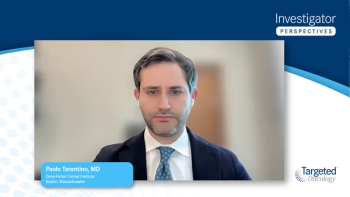
Advice on Molecular Testing and Sequencing in Unresectable HCC
A brief synopsis on optimal sequencing strategies for patients who have been diagnosed with unresectable hepatocellular carcinoma.
Episodes in this series
Richard Kim, MD: In terms of molecular profiling in HCC [hepatocellular carcinoma], in all other GI [gastrointestinal] tumors, molecular profiling is a must for all patients. In HCC, it’s a little less clear because we don’t know exactly what kind of mutations or aberrations we’re looking for at this time. At least in some practices, we are sending out tissue for profiling purposes, but I don’t think it’s used as much compared to other diseases because we don’t know exactly what to do with the profiling. In some cases in HCC, we don’t have tissue to profile. We could radiographically diagnose patients with HCC using their backgrounds and by doing an MRI or a CT scan that is consistent with HCC with arterial enhancement and portal venous washout. For those patients, I don’t have tissue to profile, so those cases would be an exception. Generally speaking, even though we should test for molecular profiling purposes to see what comes out of it and see if there are actionable aberrations, at this time I don’t think that’s being done commonly compared to the other GI tumors.
One of the biomarkers that would sometimes be used in other diseases that can predict or enrich a patient population that can potentially benefit from immunotherapy is PD-L1 status. Sometimes, if PD-L1–positive, those patients tend to benefit more from immunotherapy, for example, in GE [gastroesophageal] junction tumors. But in HCC, there’s no correlation between expression of PD-L1 and response to atezolizumab. Therefore, in our practice, we don’t do PD-L1 testing as standard testing for patients with advanced hepatocellular carcinoma.
As the treatment of hepatocellular carcinoma evolves with atezolizumab and bevacizumab in the first line, the question is, what do you do in the second line? All the second- and third-line trials so far are in patients who failed sorafenib. None of the trials were done in patients who failed immunotherapy. There are a lack of data in terms of what to do in the second line if atezolizumab and bevacizumab fail. However, most of us would prefer to use a TKI [tyrosine kinase inhibitor] in the second-line setting without much data available. This is an area where a lot of studies are being done. The question that comes up is, if you fail atezolizumab plus bevacizumab, which TKI should you use? I mentioned 4 or 5 TKIs. There’s lenvatinib [Lenvima], sorafenib, regorafenib, and cabozantinib. They’re all available. Most of them were studied in patients who failed sorafenib and not patients who failed immunotherapy, so it is unclear what to do in the second line. Without much data out there, we do tend to use one of the TKIs.
In my practice, I would probably use Lenvima, or you could use cabozantinib as well. There are some data for cabozantinib that with its mechanism of action, it blocks the AXL pathway and MET pathway, and those are some of the resistance mechanisms to VEGF inhibition. If you’re getting VEGF-targeted therapy first line and become resistant, then we may give you a TKI that blocks that AXL pathway or MET pathway and may resensitize, but it’s unclear. But in the second-line setting, a TKI will be used. In the third line, you would use a TKI that you didn’t use in the second line.
Transcript edited for clarity.







































